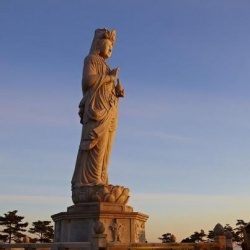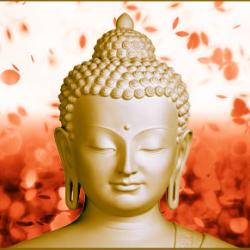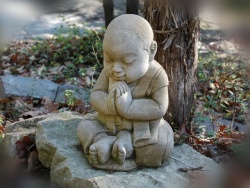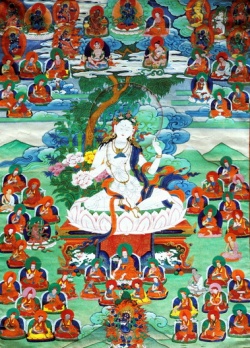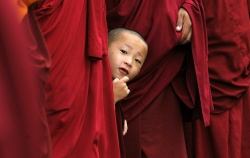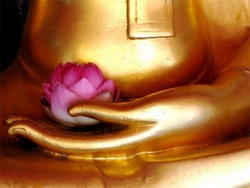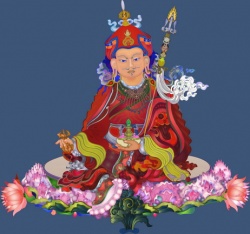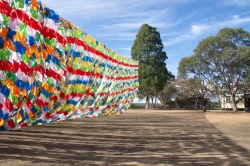Difference between revisions of "(Tibetan Buddhism)"
(Created page with " Tibetan Buddhism チベット仏教; ( Jpn Chibetto-bukkyo) A {{Wiki|distinctive}} form of Buddhism that developed in Tibet around the seventh...") |
|||
| Line 1: | Line 1: | ||
| − | + | <nomobile>{{DisplayImages|2682|746|191|513|1797|1565|671|2087|3157|1743}}</nomobile> | |
| Line 9: | Line 9: | ||
| − | A {{Wiki|distinctive}} [[form]] of [[Buddhism]] that developed in [[Tibet]] around the seventh century and later in [[Mongolia]] and other regions. It is a [[tradition]] that derives from [[Indian Mahayana]] [[Buddhism]], especially the [[doctrine]] of [[non-substantiality]] (Skt [[shunyata]] ) of the [[Madhyamika school]], and incorporates the [[doctrine]] of the [[Yogachara]] ([[Consciousness-Only]]) school as well as the [[esoteric rituals]] of [[Vajrayana]] ([[Tantric]], or [[Esoteric]], [[Buddhism]]). [[Tibetan Buddhism]] is also [[monastic]], having adopted the [[vinaya]], or [[monastic rules]], of [[early Buddhism]]. It has [[traditionally]] involved a large number of [[monks and nuns]]. [[Tibetan Buddhism]] is sometimes (incorrectly) referred to as [[Lamaism]], due to its system of "[[reincarnating]]" [[lamas]]. The title [[lama]] means a [[venerable teacher]]. Some [[lamas]] of certain [[Tibetan monasteries]] are believed to be [[successively]] [[reincarnated]], each head [[lama]] being considered a [[reincarnation]] of the last in the [[lineage]]. In these [[traditions]], sets of instructions are handed down that lead to the identification of a child believed to be the [[reincarnation]] of a previous [[lama]]. When [[signs]] point to a certain child (always a boy), he is tested, and upon passing the tests, is [[recognized]] as the [[reincarnated]] [[lama]]. He then receives [[monastic]] {{Wiki|training}} and [[education]] and takes on full responsibilities as a [[lama]] at a specified age. | + | A {{Wiki|distinctive}} [[form]] of [[Buddhism]] that developed in [[Tibet]] around the seventh century and later in [[Mongolia]] and other regions. |
| + | |||
| + | It is a [[tradition]] that derives from [[Indian Mahayana]] [[Buddhism]], especially the [[doctrine]] of [[non-substantiality]] (Skt [[shunyata]] ) of the [[Madhyamika school]], and incorporates the [[doctrine]] of the [[Yogachara]] ([[Consciousness-Only]]) school as well as the [[esoteric rituals]] of [[Vajrayana]] ([[Tantric]], or [[Esoteric]], [[Buddhism]]). | ||
| + | |||
| + | [[Tibetan Buddhism]] is also [[monastic]], having adopted the [[vinaya]], or [[monastic rules]], of [[early Buddhism]]. It has [[traditionally]] involved a large number of [[monks and nuns]]. | ||
| + | |||
| + | [[Tibetan Buddhism]] is sometimes (incorrectly) referred to as [[Lamaism]], due to its system of "[[reincarnating]]" [[lamas]]. | ||
| + | |||
| + | The title [[lama]] means a [[venerable teacher]]. Some [[lamas]] of certain [[Tibetan monasteries]] are believed to be [[successively]] [[reincarnated]], each head [[lama]] being considered a [[reincarnation]] of the last in the [[lineage]]. | ||
| + | |||
| + | In these [[traditions]], sets of instructions are handed down that lead to the identification of a child believed to be the [[reincarnation]] of a previous [[lama]]. | ||
| + | |||
| + | When [[signs]] point to a certain child (always a boy), he is tested, and upon passing the tests, is [[recognized]] as the [[reincarnated]] [[lama]]. | ||
| + | |||
| + | He then receives [[monastic]] {{Wiki|training}} and [[education]] and takes on full responsibilities as a [[lama]] at a specified age. | ||
| + | |||
| + | |||
| + | |||
| + | [[Buddhism]] evolved in [[Tibet]] in the early seventh century during the reign of [[King Songtsen Gampo]] (581-649). | ||
| + | |||
| + | A series of [[religious kings]] contributed to its adoption and eventual institution as a [[state religion]]. [[Song-tsen Gampo]] took as his wives a {{Wiki|Nepalese}} {{Wiki|princess}} and a {{Wiki|Chinese}} {{Wiki|princess}}, both of whom were devout [[Buddhists]]. | ||
| + | |||
| + | They influenced the [[king]] to take [[faith]] in [[Buddhism]] and build the first [[Buddhist temples]] in [[Tibet]]. | ||
| + | |||
| + | [[Song-tsen Gampo]] also sent [[Thonmi Sambhota]] to study [[Buddhism in India]]. | ||
| + | |||
| + | When he returned, he developed a [[Tibetan]] [[writing]] system based upon the [[Indian]] scripts he had studied ([[Tibet]] until that time had no set [[writing]] system). | ||
| + | |||
| + | With this [[Wikipedia:Tibetan alphabet|Tibetan script]], translation of [[Sanskrit]] [[Buddhist texts]] into [[Tibetan]] began. | ||
| + | |||
| + | |||
| + | |||
| + | |||
| + | Later [[King]] [[Thisong Detsen]] (742-797) further established [[Buddhism in Tibet]] against strong [[opposition]] from practitioners of the native [[religion]] called [[Bon]]. | ||
| + | |||
| + | He invited [[Shantarakshita]], a noted [[Indian monk]] of the [[Madhyamika school]], to come to [[Tibet]] to teach [[Buddhism]]. On Shan-tarakshita's advice, the [[king]] also invited the [[Indian]] [[Tantric master]] [[Padmasambhava]]. | ||
| + | |||
| + | [[Padmasambhava]] is credited with "converting" the [[Bon]] [[deities]] to [[Buddhism]] (incorporating them into the [[Buddhist teachings]]) and quelling [[Bon]] [[opposition]]. [[Shantarakshita]] and [[Padmasambhava]] together established [[Tibet's]] first [[monastery]] at [[Samye]] in 779. | ||
| + | |||
| + | The [[Nyingma]], one of today's four major [[Tibetan Buddhist]] schools, claims to preserve the teachings of [[Padmasambhava]]. | ||
| + | |||
| + | [[King]] [[Thisong Detsen]] also sponsored a [[religious]] [[debate]] between [[Kamalashila]], an [[Indian monk]], and [[Mo-ho-yen]], a {{Wiki|Chinese}} [[priest]] of the [[Zen]] ([[Ch'an]]) school, held at the [[Samye monastery]] in 794. | ||
| + | |||
| + | The [[king]] decided in favor of the [[Indian]] [[teacher]] and thus officially adopted the teachings of [[Indian Buddhism]], or more specifically, the [[Mahayana teachings]] founded on [[Nagarjuna's]] [[philosophy]] of the [[Madhyamika school]] and the [[bodhisattva ideal]]. | ||
| + | |||
| + | He rejected the introspective [[doctrines]] of [[Zen]] that claimed to ensure [[sudden enlightenment]] through meditation. | ||
| + | |||
| + | King [[Trhitsug Detsen]] (806-841), a grandson of [[King]] [[Thisong Detsen]], built [[temples]] and [[monasteries]] and contributed greatly to the translation of [[Sanskrit]] [[Buddhist scriptures]] into [[Tibetan]] as well as to [[Buddhist art]] and {{Wiki|culture}}. | ||
| + | |||
| + | According to one account, in 841 [[Bon]] followers had him assassinated, and his brother, [[Langdarma]], succeeded him. | ||
| + | |||
| + | The new [[king]] opposed [[Buddhism]]. | ||
| + | |||
| + | He destroyed [[temples]] and [[monasteries]], oppressed [[Buddhist monks]], and abolished [[Buddhism]] as an institution; it was not restored until two centuries later. | ||
| + | |||
| + | According to another account, the [[death]] of [[King Langdarma]] led to a power struggle that resulted in the [[division]] of the {{Wiki|nation}} and a collapse of the [[Buddhist Order]]. | ||
| + | |||
| + | In either case, after a period of {{Wiki|political}} and [[religious]] turmoil, the [[ruler]] of [[western Tibet]] invited [[Atisha]], an [[Indian Buddhist]] [[teacher]] of the [[Madhyamika school]], to the region in 1042 to help restore [[Buddhism]]. | ||
| + | |||
| + | |||
| + | |||
| + | [[Atisha]] propagated [[Buddhist teachings]], reformed [[Tantric practices]] that had involved overt {{Wiki|sexual}} [[activity]], and brought about a revival of [[Buddhism]]. [[Atisha's]] teachings were inherited by his [[disciple]] [[Dromton]], who founded the [[Kadam school]] of [[Tibetan Buddhism]]. | ||
| + | |||
| + | (Later this school was absorbed by the [[Gelug school]], also known as the [[Yellow Hat]] school, which was founded in the late fourteenth century by [[Tsongkapa]], a [[Buddhist]] reformer.) | ||
| + | |||
| + | In the same century, [[Marpa]] returned to [[Tibet]] from his journey to [[India]] to study [[Buddhism]] and, with his [[disciple]] [[Milarepa]], founded the [[Kagyu school]]. | ||
| + | |||
| + | By the fourteenth century, [[Buddhism]] was well established in [[Tibet]], and most of the available [[Indian]] [[scriptures]] had been translated into [[Tibetan]]. | ||
| + | |||
| + | A number of lost [[Sanskrit]] [[scriptures]] have been preserved until today through their [[Tibetan]] translations. | ||
| + | |||
| + | |||
| + | |||
| + | [[Tibetan Buddhism]] also spread outside of [[Tibet]], most notably in [[Mongolia]] and the [[Mongol Empire]]. In the mid-thirteenth century, [[Sakya Pandita]], an {{Wiki|eminent}} [[scholar]] of the [[Sakya school]] of [[Tibetan Buddhism]], journeyed to [[Mongolia]] with his nephew and [[student]], [[Phagpa]]. | ||
| + | Deeply impressed by them, {{Wiki|Mongol}} officials converted to [[Buddhism]]. | ||
| − | [[ | + | Later [[Phagpa]] was appointed {{Wiki|imperial}} [[teacher]] and became an adviser to [[Kublai Khan]], the [[ruler]] of the [[Mongol Empire]]. He was also appointed the {{Wiki|temporal}} [[ruler]] of [[Tibet]]. |
| + | In 1578 the {{Wiki|Mongolian}} [[ruler]] [[Altan Khan]] hosted the renowned [[Sonam Gyatso]], the leader of the [[Gelug school]] of [[Tibetan Buddhism]], and conferred upon him the [[honorific title]] "[[Dalai Lama]]." [[Dalai]] is a {{Wiki|Mongolian}} [[word]] for ocean. | ||
| − | + | The title was also applied to his two predecessors. | |
| − | |||
| + | With the aid of the {{Wiki|Mongols}}, the [[Gelug school]] and its [[lineage]] of [[Dalai Lamas]] became the most prominent and powerful in [[Tibet]]. | ||
| − | [[ | + | [[The Dalai Lama]] came to be regarded as the country's [[spiritual]] leader and {{Wiki|temporal}} [[ruler]], and each was believed to be a successive [[incarnation]] of the [[bodhisattva Avalokiteshvara]], [[Perceiver of the World's Sounds]]. |
| + | Since the popular uprising against {{Wiki|Chinese}} {{Wiki|rule}} in [[Tibet]] in 1959 and the resulting exile of the [[fourteenth Dalai Lama]], [[Tenzin Gyatso]] (b. 1935), and his followers, [[interest]] in [[Tibetan Buddhism]] has grown in the [[West]]. | ||
| − | + | The [[Nyingma]], [[Kagyu]], [[Sakya]], and [[Gelug]] are the four major [[schools of Tibetan Buddhism]], the [[Gelug]] being the most prominent. | |
{{R}} | {{R}} | ||
http://www.sgilibrary.org/search_dict.php | http://www.sgilibrary.org/search_dict.php | ||
[[Category:Tibetan Buddhism]] | [[Category:Tibetan Buddhism]] | ||
Revision as of 19:39, 7 December 2015
Tibetan Buddhism チベット仏教; ( Jpn Chibetto-bukkyo)
A distinctive form of Buddhism that developed in Tibet around the seventh century and later in Mongolia and other regions.
It is a tradition that derives from Indian Mahayana Buddhism, especially the doctrine of non-substantiality (Skt shunyata ) of the Madhyamika school, and incorporates the doctrine of the Yogachara (Consciousness-Only) school as well as the esoteric rituals of Vajrayana (Tantric, or Esoteric, Buddhism).
Tibetan Buddhism is also monastic, having adopted the vinaya, or monastic rules, of early Buddhism. It has traditionally involved a large number of monks and nuns.
Tibetan Buddhism is sometimes (incorrectly) referred to as Lamaism, due to its system of "reincarnating" lamas.
The title lama means a venerable teacher. Some lamas of certain Tibetan monasteries are believed to be successively reincarnated, each head lama being considered a reincarnation of the last in the lineage.
In these traditions, sets of instructions are handed down that lead to the identification of a child believed to be the reincarnation of a previous lama.
When signs point to a certain child (always a boy), he is tested, and upon passing the tests, is recognized as the reincarnated lama.
He then receives monastic training and education and takes on full responsibilities as a lama at a specified age.
Buddhism evolved in Tibet in the early seventh century during the reign of King Songtsen Gampo (581-649).
A series of religious kings contributed to its adoption and eventual institution as a state religion. Song-tsen Gampo took as his wives a Nepalese princess and a Chinese princess, both of whom were devout Buddhists.
They influenced the king to take faith in Buddhism and build the first Buddhist temples in Tibet.
Song-tsen Gampo also sent Thonmi Sambhota to study Buddhism in India.
When he returned, he developed a Tibetan writing system based upon the Indian scripts he had studied (Tibet until that time had no set writing system).
With this Tibetan script, translation of Sanskrit Buddhist texts into Tibetan began.
Later King Thisong Detsen (742-797) further established Buddhism in Tibet against strong opposition from practitioners of the native religion called Bon.
He invited Shantarakshita, a noted Indian monk of the Madhyamika school, to come to Tibet to teach Buddhism. On Shan-tarakshita's advice, the king also invited the Indian Tantric master Padmasambhava.
Padmasambhava is credited with "converting" the Bon deities to Buddhism (incorporating them into the Buddhist teachings) and quelling Bon opposition. Shantarakshita and Padmasambhava together established Tibet's first monastery at Samye in 779.
The Nyingma, one of today's four major Tibetan Buddhist schools, claims to preserve the teachings of Padmasambhava.
King Thisong Detsen also sponsored a religious debate between Kamalashila, an Indian monk, and Mo-ho-yen, a Chinese priest of the Zen (Ch'an) school, held at the Samye monastery in 794.
The king decided in favor of the Indian teacher and thus officially adopted the teachings of Indian Buddhism, or more specifically, the Mahayana teachings founded on Nagarjuna's philosophy of the Madhyamika school and the bodhisattva ideal.
He rejected the introspective doctrines of Zen that claimed to ensure sudden enlightenment through meditation.
King Trhitsug Detsen (806-841), a grandson of King Thisong Detsen, built temples and monasteries and contributed greatly to the translation of Sanskrit Buddhist scriptures into Tibetan as well as to Buddhist art and culture.
According to one account, in 841 Bon followers had him assassinated, and his brother, Langdarma, succeeded him.
The new king opposed Buddhism.
He destroyed temples and monasteries, oppressed Buddhist monks, and abolished Buddhism as an institution; it was not restored until two centuries later.
According to another account, the death of King Langdarma led to a power struggle that resulted in the division of the nation and a collapse of the Buddhist Order.
In either case, after a period of political and religious turmoil, the ruler of western Tibet invited Atisha, an Indian Buddhist teacher of the Madhyamika school, to the region in 1042 to help restore Buddhism.
Atisha propagated Buddhist teachings, reformed Tantric practices that had involved overt sexual activity, and brought about a revival of Buddhism. Atisha's teachings were inherited by his disciple Dromton, who founded the Kadam school of Tibetan Buddhism.
(Later this school was absorbed by the Gelug school, also known as the Yellow Hat school, which was founded in the late fourteenth century by Tsongkapa, a Buddhist reformer.)
In the same century, Marpa returned to Tibet from his journey to India to study Buddhism and, with his disciple Milarepa, founded the Kagyu school.
By the fourteenth century, Buddhism was well established in Tibet, and most of the available Indian scriptures had been translated into Tibetan.
A number of lost Sanskrit scriptures have been preserved until today through their Tibetan translations.
Tibetan Buddhism also spread outside of Tibet, most notably in Mongolia and the Mongol Empire. In the mid-thirteenth century, Sakya Pandita, an eminent scholar of the Sakya school of Tibetan Buddhism, journeyed to Mongolia with his nephew and student, Phagpa.
Deeply impressed by them, Mongol officials converted to Buddhism.
Later Phagpa was appointed imperial teacher and became an adviser to Kublai Khan, the ruler of the Mongol Empire. He was also appointed the temporal ruler of Tibet.
In 1578 the Mongolian ruler Altan Khan hosted the renowned Sonam Gyatso, the leader of the Gelug school of Tibetan Buddhism, and conferred upon him the honorific title "Dalai Lama." Dalai is a Mongolian word for ocean.
The title was also applied to his two predecessors.
With the aid of the Mongols, the Gelug school and its lineage of Dalai Lamas became the most prominent and powerful in Tibet.
The Dalai Lama came to be regarded as the country's spiritual leader and temporal ruler, and each was believed to be a successive incarnation of the bodhisattva Avalokiteshvara, Perceiver of the World's Sounds.
Since the popular uprising against Chinese rule in Tibet in 1959 and the resulting exile of the fourteenth Dalai Lama, Tenzin Gyatso (b. 1935), and his followers, interest in Tibetan Buddhism has grown in the West.
The Nyingma, Kagyu, Sakya, and Gelug are the four major schools of Tibetan Buddhism, the Gelug being the most prominent.
